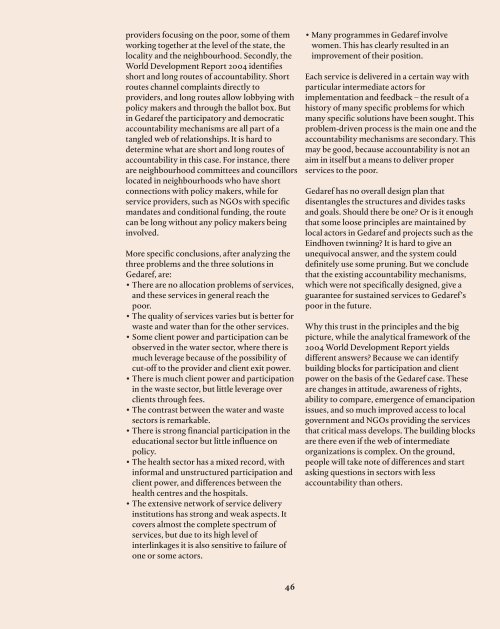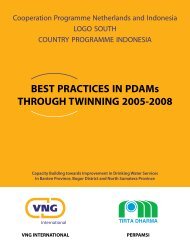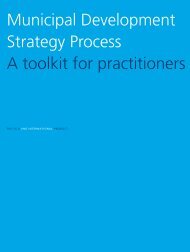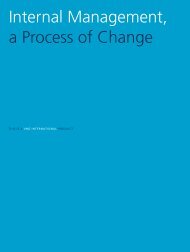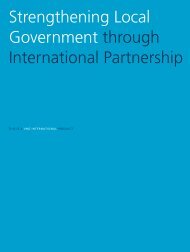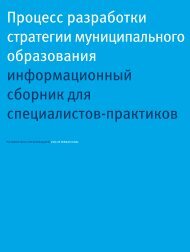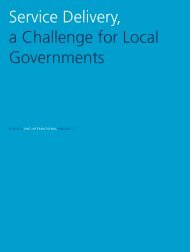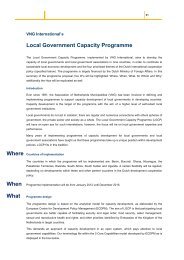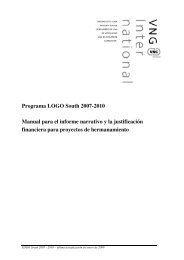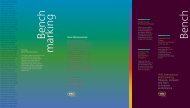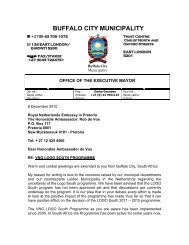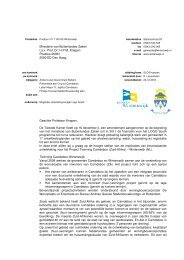Opmaak 1 - VNG International
Opmaak 1 - VNG International
Opmaak 1 - VNG International
You also want an ePaper? Increase the reach of your titles
YUMPU automatically turns print PDFs into web optimized ePapers that Google loves.
providers focusing on the poor, some of them<br />
working together at the level of the state, the<br />
locality and the neighbourhood. Secondly, the<br />
World Development Report 2004 identifies<br />
short and long routes of accountability. Short<br />
routes channel complaints directly to<br />
providers, and long routes allow lobbying with<br />
policy makers and through the ballot box. But<br />
in Gedaref the participatory and democratic<br />
accountability mechanisms are all part of a<br />
tangled web of relationships. It is hard to<br />
determine what are short and long routes of<br />
accountability in this case. For instance, there<br />
are neighbourhood committees and councillors<br />
located in neighbourhoods who have short<br />
connections with policy makers, while for<br />
service providers, such as NGOs with specific<br />
mandates and conditional funding, the route<br />
can be long without any policy makers being<br />
involved.<br />
More specific conclusions, after analyzing the<br />
three problems and the three solutions in<br />
Gedaref, are:<br />
• There are no allocation problems of services,<br />
and these services in general reach the<br />
poor.<br />
• The quality of services varies but is better for<br />
waste and water than for the other services.<br />
• Some client power and participation can be<br />
observed in the water sector, where there is<br />
much leverage because of the possibility of<br />
cut-off to the provider and client exit power.<br />
• There is much client power and participation<br />
in the waste sector, but little leverage over<br />
clients through fees.<br />
• The contrast between the water and waste<br />
sectors is remarkable.<br />
• There is strong financial participation in the<br />
educational sector but little influence on<br />
policy.<br />
• The health sector has a mixed record, with<br />
informal and unstructured participation and<br />
client power, and differences between the<br />
health centres and the hospitals.<br />
• The extensive network of service delivery<br />
institutions has strong and weak aspects. It<br />
covers almost the complete spectrum of<br />
services, but due to its high level of<br />
interlinkages it is also sensitive to failure of<br />
one or some actors.<br />
• Many programmes in Gedaref involve<br />
women. This has clearly resulted in an<br />
improvement of their position.<br />
Each service is delivered in a certain way with<br />
particular intermediate actors for<br />
implementation and feedback – the result of a<br />
history of many specific problems for which<br />
many specific solutions have been sought. This<br />
problem-driven process is the main one and the<br />
accountability mechanisms are secondary. This<br />
may be good, because accountability is not an<br />
aim in itself but a means to deliver proper<br />
services to the poor.<br />
Gedaref has no overall design plan that<br />
disentangles the structures and divides tasks<br />
and goals. Should there be one? Or is it enough<br />
that some loose principles are maintained by<br />
local actors in Gedaref and projects such as the<br />
Eindhoven twinning? It is hard to give an<br />
unequivocal answer, and the system could<br />
definitely use some pruning. But we conclude<br />
that the existing accountability mechanisms,<br />
which were not specifically designed, give a<br />
guarantee for sustained services to Gedaref’s<br />
poor in the future.<br />
Why this trust in the principles and the big<br />
picture, while the analytical framework of the<br />
2004 World Development Report yields<br />
different answers? Because we can identify<br />
building blocks for participation and client<br />
power on the basis of the Gedaref case. These<br />
are changes in attitude, awareness of rights,<br />
ability to compare, emergence of emancipation<br />
issues, and so much improved access to local<br />
government and NGOs providing the services<br />
that critical mass develops. The building blocks<br />
are there even if the web of intermediate<br />
organizations is complex. On the ground,<br />
people will take note of differences and start<br />
asking questions in sectors with less<br />
accountability than others.<br />
46


